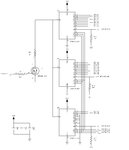djnik1362
Full Member level 2
Hi Everyone
I design a circuit to multiplex 18 IR Receiver Diodes to a Driver Circuit as depict in following picture :

Despite the wrong connection for MUX Enable (must be GND to be enabled) there is huge transient
during MUX switching (about 4ms) .
On the other side of the circuit each diode connected to +5V at K and it's A is connected to MUXes.
Do you have any suggestion for this problem or whole circuit ? (May be i do something wrong in Driver Circuit too)
Thanks for your help.
I design a circuit to multiplex 18 IR Receiver Diodes to a Driver Circuit as depict in following picture :

Despite the wrong connection for MUX Enable (must be GND to be enabled) there is huge transient
during MUX switching (about 4ms) .
On the other side of the circuit each diode connected to +5V at K and it's A is connected to MUXes.
Do you have any suggestion for this problem or whole circuit ? (May be i do something wrong in Driver Circuit too)
Thanks for your help.
